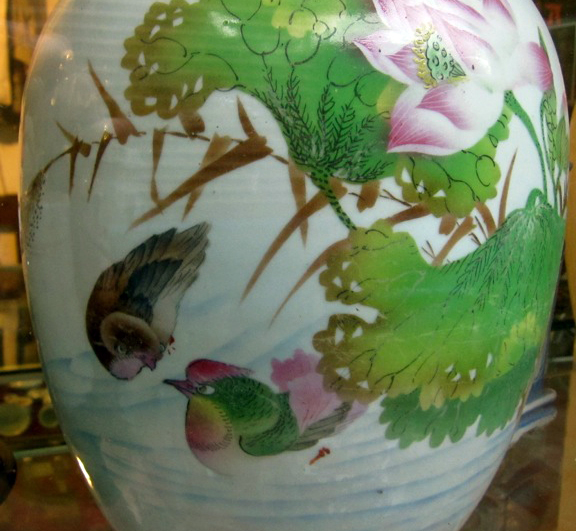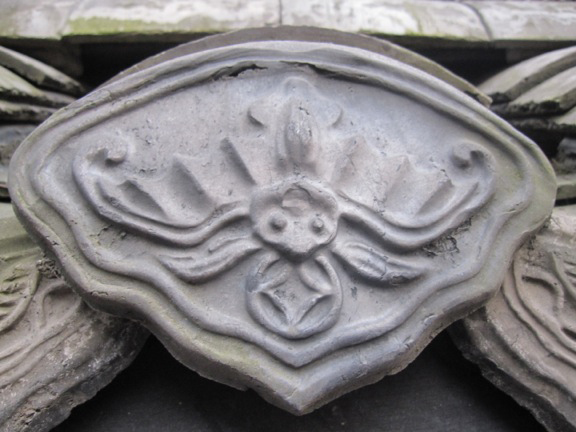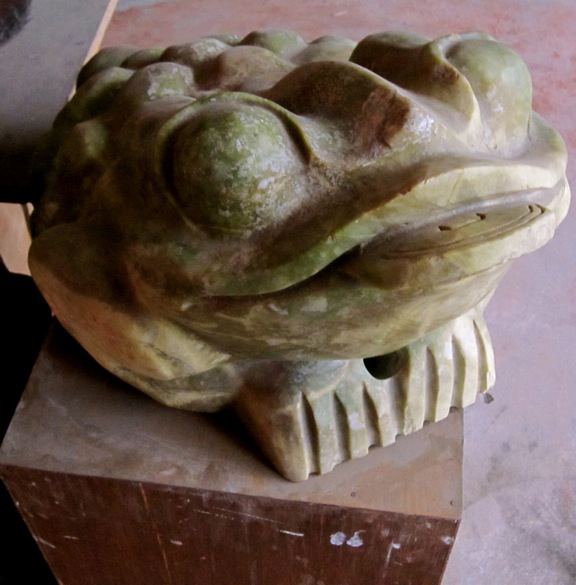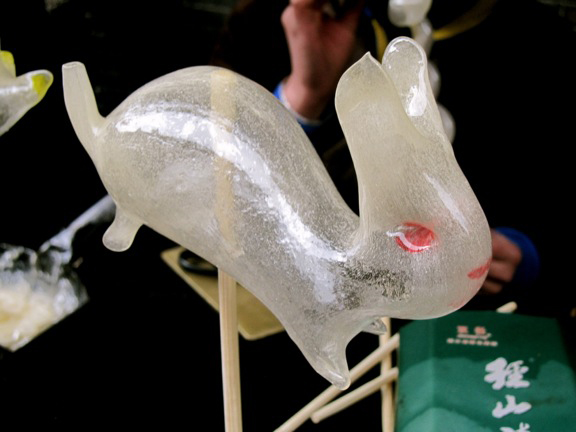We’ve all enjoyed the occasional stroll through an old town, old street, or antique market. We’ve all been overwhelmed by the overabundance of choices at these places. We’ve all been frustrated trying to understand the symbolism behind the exquisite (or not so exquisite) detail on a tea cup, t-shirt, painting or pot. Somehow the phrase often uttered by local friends “it means good luck” doesn’t suffice on its own. We need more.
The purpose of this article, and those that follow, is to decode some of the most common images seen in art and sculpture in Chengdu. Animals, plants, and people are my primary targets.
I should mention that I am no expert. My research comes from local sellers, local people, the internet, and books. I hope you start to notice these things in your day-to-day Chengdu life, and in fact, you probably won’t stop seeing them. It’s kind of a disease, really, but hey, it keeps your mind off the smog. In all seriousness, I really hope it enhances your experience as much as it has mine.
Part 1: Animals of Chinese Lore
Animals play an enormous role in Chinese Folk Art. Most pieces have one roaming around somewhere and usually carry some symbolic meaning, so we’ll take a look at ten of the most common that I find around Chengdu.
The Crane (“he” ?)
Cranes are commonly used as symbols of longevity, because according to legends, they lived for hundreds of years. I one perched on a beautiful vase at the Songxian Qiao antique market. It appears to be holding peaches (tao2zi ??) which are symbols of immortality. Because of this pairing of images, the salesman said that this gift should be given to an elderly person. He even went so far as to say that it is inappropriate for a young guy like me to buy it (or anything with cranes) for myself. Cranes are most often seen building Chengdu’s skyline in pairs with other symbols of longevity, such as a pine or cypress tree.

The Mandarin Duck (“yuan yang” ??)
I saw a lot of Mandarin Ducks floating around Songxian Qiao. As tradition states, this couple is a sign of fidelity or marital bliss. The reason being that apparently one can not survive without the other. On one vase I picked up, the ducks are pictured with a lotus and bamboo. According to the salesman, the bamboo (zhu2 ?) means ‘wish’, the lotus (he2 ?) indicates ‘peace’ and the lotus seedpod, peeking out of the middle part of the flower, marks represents a hope for children. Needless to say, this vase was a favorite of my translator (wife).
The Bat (“fu” ?)
There was a roof tile that looked like a great halloween decoration to me, but to the locals, it has another connotation: happiness and good fortune. Sorry, I know, its the ‘good luck’ I was talking about, but we’ll give this one a pass. The word for bat (fu2 ?) is a homophone of the word for happiness (fu2 ?). So bats are used often to portray this wish, usually among the stylized clouds (yun2 ?) which is a homophone for good fortune (yun4 ?). This one, which I found at Jinli Street, seems to have a coin with it, which makes its own motif, according to one source, this coin is known as an “eye coin” (yan3qian2 ??), which forms an interesting wordplay: “happiness (fu2 ?) lies (zai4 ?) before (qian2 ? ) [your] eyes (yan3 ?). It’s so interesting it almost makes me like bats.
The Dragon (“long” ?)
The cool kid in town is of course the dragon. They come in all shapes and sizes, but typically carry the same message of power and protection. The dragon has 9 “sons” who occupy different places, such as door knockers, bells, rooftops, and bridges. This dragon appears to be flying among the clouds (yun2 ?), which symbolize good fortune. You have probably seen portrayals of a dragon chasing a ball of fire. This suggests the magical powers of the dragon, a kind of “pearl of wisdom”. Last word on the dragon: be sure to ask which one it is you are buying/tattooing, as they might have a special association other than just power and protection.

The Qilin (“qi lin” ??)
I found a lot of this mythological creature – which I thought was a liger or something – called a qilin (pronounced “chee-lin”). It has a dragon’s head, a scaled body, deer hooves, and a bear’s tail. Typically they are a symbol of honor and intelligence. This qilin carries a baby boy on its back. According to the salesman, this is given as a gift to parents who want to have a baby boy (qi2lin2song4zi ????). It seems like an odd couple to me.
The Rabbit (“tu zi” ??)
As one of the twelve animals of the Chinese zodiac, rabbits are a popular animal in Chinese culture. This blown candy from Jinli street no doubt alludes to the zodiac, as kids spin the wheel to see which animal candy they will receive. But more often in Chinese art, they will be a sign of immortality. According to legend, a “moon hare” (yue4tu4 ???accompanies the Goddess of the moon, Chang’e. Images of a rabbit with a mortar and pestle are said to be preparing an “elixir of immortality.” In general, rabbits tend to be symbols of the moon, and a rooster is a symbol of the sun.

The Toad (“chan chu” ??)
No doubt, you have seen these around Chengdu. I found this one at the antique market. They are called “money toads” (qian2chan2 ??). According to my research this animal is surrounded by myths and legend, but is mainly seen as a good luck charm today. Businesses sometimes put this, or a gold cat, in their store to bring good luck and presumably, wealth.
The Tiger (“lao hu” ??)
According to the Chinese zodiac, I am a tiger. It’s a perfect representation of your’s truly because it means strength, power, and courage (ok, maybe not so perfect for me). Nevertheless, it is a popular figure in Chinese art and chances are you’ve run into a couple of them. This unique one is actually a hat, fashioned in the style of the Qing Dynasty, according to the salesman. Most images of tigers will have the Chinese character for king?wang ?) on its forehead, further signifying its power.
The Goldfish (“jin yu” ??)
Almost every tourist attraction around Chengdu has a place for you to feed goldfish. Goldfish in Chinese (jin1yu2 ??) lends itself to some very positive associations. The word jin (?) means ‘gold’. The word for ‘fish’ (?) has the same sound as the word for jade (yu4 ?) and ‘surplus’ (yu2 ?). So if you see goldfish in paintings or teapots, typically surrounded by other symbols of luck, they represent some kind of a hope or wish for wealth of money or happiness.

The Lion (“shi” ?)
Here we come to the final animal of this edition, the lion. Cruise through Chengdu and you will see these guys protecting the gates or doors of buildings. They exude their majestic strength and beauty for all to see. Often they will be seen holding a ball. This is meant to represent the same “pearl” that the dragon was after. According to my this book on Chinese symbology, the lion and dragon pursued the pearl of wisdom as sort of “fight for supremacy”. The number of bumps on the head used to indicate the rank of the official behind the doors. The higher the number, the higher the rank. The lions in this picture stand guard outside the main office building of Sichuan Normal University.
Plants & Flowers Coming Up Next
I hope this guides your next gift purchase, or heightens your appreciation of Chinese art and culture. Be sure to catch the next edition, where we take a look at some plants and flowers. If you have any questions, or want to request something for the next edition, be sure to leave a comment below.
There is some interesting information in here, I hope an expert steps in and drops some knowledge in the comment section. Like what are the bumps referring to officials all about and how do you read them? Who wins the fight for the pearl? What do you get when you snatch the pearl.
I like the bat one … wordplay is really interesting in China …
Glad to see the article up. It took a long time to research. Hard to choose what to include and not. Hope it can help y’all out!
This is a really insightful post, thanks for contributing it Ben. You are a fine writer, as Sascha says.
The interesting thing about these symbols is that once you learn them, you begin to see them everywhere. I noticed the same thing with certain Chinese characters – when I learned them, I began seeing them all around me.
When I read this article, the first thing I thought of were the lions that flank the entrance to every bank. The male on one side with the ball and the female with the cub. The detail on those sculptures are incredible, I once heard a story about how they’re made by a small number of highly skilled sculptors who sell them for enormous sums of money. This stuff is real Chinese culture.
Thanks, Charlie!
Yeah, it does make the trips to the souvenir shops a lot more fun. This just scratches the surface, but we have to start somewhere.
My wife told me that another good way to understand Chinese culture is to read “Journey to the West.” I’m working through that now too. And its safe to say the book is much better than the movie. 😉
Ben, are you reading that in Chinese or English? I believe you when you say the book is better, hahah.
Side note: a major, big-budget theatrical version of The Monkey King is coming out in 2013, co-starring Chow Yun Fat.
I’m reading it in English. The translation is horrible, but I picked it up at the airport so I didn’t have much choice. Still better than the movie though, haha.
Thanks for the heads-up! Being such an important part of Chinese literature, I’m surprised there hasn’t been any good adaptations yet.
I have a good version of that series at home, if your translation sucks real bad, i may be able to lend one out.
This was a GREAT read!I always wondered why theres so much depictions and statues of lions in the chinese modern and pre modern ar t though lions never existed in china….
That is a good point – I never thought about the fact that lions aren’t actually in China despite appearing in all the imagery. I guess you could say the same of dragons, though. I wonder what the origin of all the lion imagery is.
yet dragons are merely the product of chinese (and western) mythology and an exaggerated take on reptiles. In the chinese realm of big cats, tigers being fierless and brave should be IMO displayed outside fancy and official buildings instead of the curly-haired odd looking lion…
Helpful stuff! People don’t realize how much a difference it makes when you can actually identify the stuff in your daily field of vision.
But you forgot the best one: píxiū 貔貅。